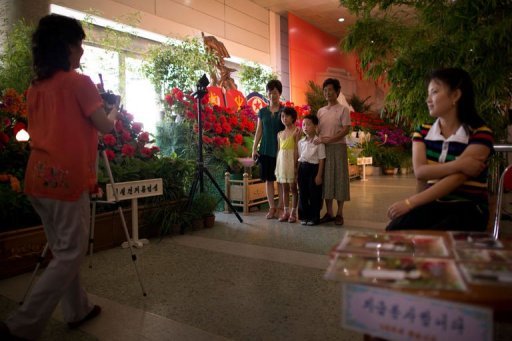It’s a long way from your average flower show, with mock missiles bristling behind the begonias, and garden gnome-sized troops lobbing grenades over a bed of orchids.
But then, as the North Korean staff inside the cavernous bloom-decked exhibition hall in Pyongyang are quick to point out, these are far from average flowers.
The red begonias are actually Kimjongilia, named after late leader Kim Jong-Il, while the orchids are Kimilsungia — after his father and the nation’s founder Kim Il-Sung.
Both flowers dominated the 70 large-scale displays taking up three floors of the hall in a special show to mark the 60th anniversary of the 1950-53 Korean War ceasefire.
The signing of the armistice is celebrated as “Victory Day” in North Korea and the martial theme was laid on with a large trowel.
Most of the floral displays utilised military statuary, many showing a proud soldier carrying the national flag into battle over the flowerpots.
Some went for actual battlefield action, with metre-high figurines of heavy machine gunners and grenade throwers embedded between the Kimjongilia, whose large blooms and thick stems provided better cover than the more delicate Kimilsungia.
Also prominent were scaled down models of the Unha-3 rocket with which North Korea successfully placed a satellite in orbit last December.
Most of the international community viewed the launch as a disguised ballistic missile test and the UN Security Council tightened sanctions on Pyongyang as a result.
Each floral display was put together by a different state institution, ministry or committee, and some chose to personalise their efforts to reflect their own work.
Instead of armed troops, one trade body decorated its flower beds with its products, including a CNC milling machine, some rolls of patterned textiles and bags of fertiliser.
The Committee For the Peaceful Reunification of Korea had its flowers arranged in the shape of a map of the entire Korean peninsula, with Pyongyang marked by a slightly taller, rotating flower pot.
The national flower of North Korea is the magnolia, and the blooms named after the two late leaders were both provided by outsiders.
Late Indonesian president Sukarno presented Kim Il-Sung with his orchid namesake, and the Kimjongilia was grown by a Japanese botanist.
Asked whether native Korean varieties would not have been more appropriate, the guide said the fact that they were presented by foreigners made them more significant.
Factory worker Jiang Ok-Sil took time off work to visit the exhibition with her five-year-old daughter.
Pressed to choose her favourite, Jiang hesitated before opting for the Kimilsungia which “looked more beautiful”.

COMMENTS
Please let us know if you're having issues with commenting.